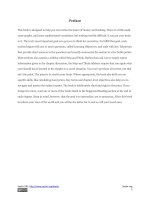Money and Banking: Lecture 28
Bạn đang xem bản rút gọn của tài liệu. Xem và tải ngay bản đầy đủ của tài liệu tại đây (720.05 KB, 25 trang )
Money and
Banking
Lecture 28
McGrawHill/Irwin
Copyright © 2006 by The McGrawHill Companies, Inc. All rights reserved.
Review of the Previous Lecture
• Non-depository Institutions
• Insurance Companies
• Securities Firms
• Brokerage Firms
Topics under Discussion
• Securities Firms
• Investment Banks
• Mutual Funds
• Finance Companies
• Government Sponsored Enterprises
• Banking Crisis
• Sources of Runs, Panics and Crisis
• Government Safety Net
• Government: Lender of Last Resort
Securities Firms
• Investment banks are the conduits through
which firms raise funds in the capital
markets
• Through their underwriting services,
investment banks issue new stocks and a
variety of other debt instruments
Securities Firms
• In underwriting, the investment bank
guarantees the price of a new issue and then
sells it to investors at a higher price;
• However, this is not without risk, since the selling
price may not in fact be higher than the price
guaranteed to the firm issuing the security
Securities Firms
• Information and reputation are central to
the underwriting business;
• underwriters collect information to determine
the price of the new securities and then put
their reputations on the line when they go out
to sell the issues
• In addition to underwriting, investment
banks provide advice to firms that wish to
merge with or acquire other firms, for
which advice they are paid a fee
Finance Companies
• Finance companies raise funds in the
financial markets by issuing commercial
paper and securities and use the funds to
make loans to individuals and corporations
• These companies are largely concerned
with reducing the transactions and
information costs that are associated with
intermediated finance
Finance Companies
• Most finance companies specialize in one
of three loan types:
• consumer loans,
• business loans,
• sales loans (for example, the financing for a
consumer to purchase a large-ticket item like
an appliance).
• Some also provide commercial and home
mortgages
Finance Companies
• Business finance companies provide loans
to businesses, for equipment leasing
• Business finance companies also provide
short-term liquidity to firms by offering
• inventory loans (so that firms can keep the
shelves stocked)
• accounts receivable loans (which provide
immediate resources against anticipated
revenue streams)
Government-Sponsored Enterprises
• The government is directly involved in the
financial intermediation system through loan
guarantees and in the chartering of financial
institutions to provide specific types of financing
•
•
•
•
Zarai Taraqiati Bank Limited (ZTBL)
Small and Medium Enterprise (SME) Bank
House Building Finance Corporation (HBFC)
Khushhali Bank
Banking Crisis
• Banking crises are not a new phenomena;
the history of commercial banking over the
last two centuries is replete with period of
turmoil and failure.
• By their very nature, financial systems are
fragile and vulnerable to crisis
South Asian
Crisis
The Sources and Consequences of Runs,
Panics, and Crises
• In a market based economy, the opportunity
to succeed is also the opportunity to fail!
• Banks serve some essential functions in the
economy
• Access to payment system
• Screen and monitor borrowers to reduce
information problems
• So if bank fails, we lose ability to make
financial transactions. Collectively, the
economy is endangered.
The Sources and Consequences of Runs,
Panics, and Crises
• Banks’ fragility arises from the fact that
they provide liquidity to depositors,
allowing them to withdraw their balances
on demand, on a first-come, first-served
basis
• If bank can not meet this promise of
withdrawal, because of insufficient funds,
it will fail
• Reports that a bank has become insolvent
can spread fear that it will run out of cash
and close its doors;
• Depositors will rush to convert their balances
into cash
• such a run on a bank can cause it to fail
• What matters during a bank run is not
whether a bank is solvent but whether it is
liquid
• Here solvency means that the value of the
bank’s assets exceeds its liabilities (positive net
worth)
• Liquidity refers to the sufficient reserves of the
bank to meet withdrawal demands
• False rumors that a bank is insolvent can
lead to a run which renders it illiquid
• When a bank fails, depositors may lose
some or all of their deposits, and
information about borrowers’
creditworthiness may disappear;
• For this reason, governments take steps
to try to minimize the risk of failure
• A single bank failure can also turn into a
system-wide panic; this is called contagion
• While banking panics and financial crises can
result from false rumors, they can also occur for
more concrete reasons;
• anything that affects borrowers’ ability to repay their
loans or drives down the market price of securities
has the potential to imperil the bank’s finances
• Recessions have a clear negative impact on bank’s
balance sheet
• Low profitability of firm makes debt repayment much
harder
• People lose jobs and cant pay their loan
• With the rise of default risk, bank’s assets
lose value and capital drops
• With less capital, banks are forced to
contract the balance sheet making fewer
loans.
• The overall business investment falls and
bank failure is more possible
• Historically, downturns in the business
cycle put pressure on banks, substantially
increasing the risk of panics
• Financial disruptions can also occur
whenever borrowers’ net worth falls, as it
does during deflation
Summary
• Non-depository Institution
•
•
•
•
Insurance Companies
Securities Firms
Finance Companies
Govt. Sponsored Enterprises
• Bank Crisis
• Sources of Bank Runs, Panics and crisis`









